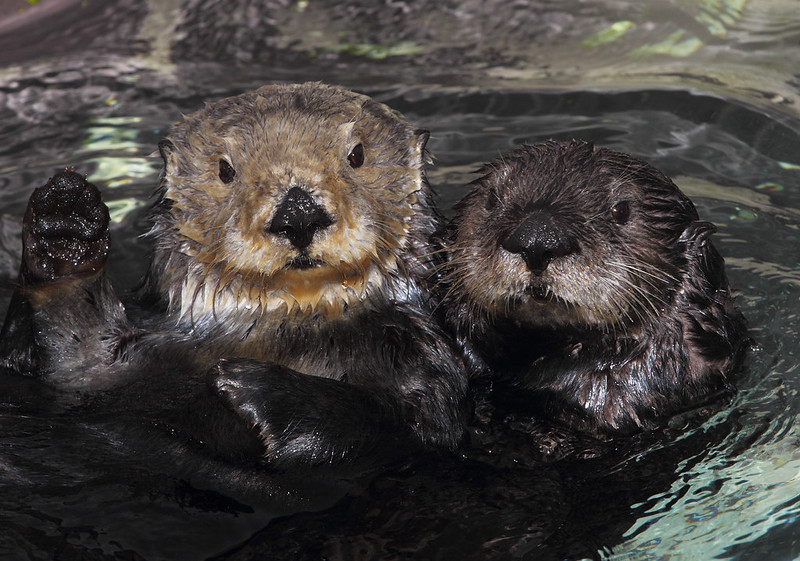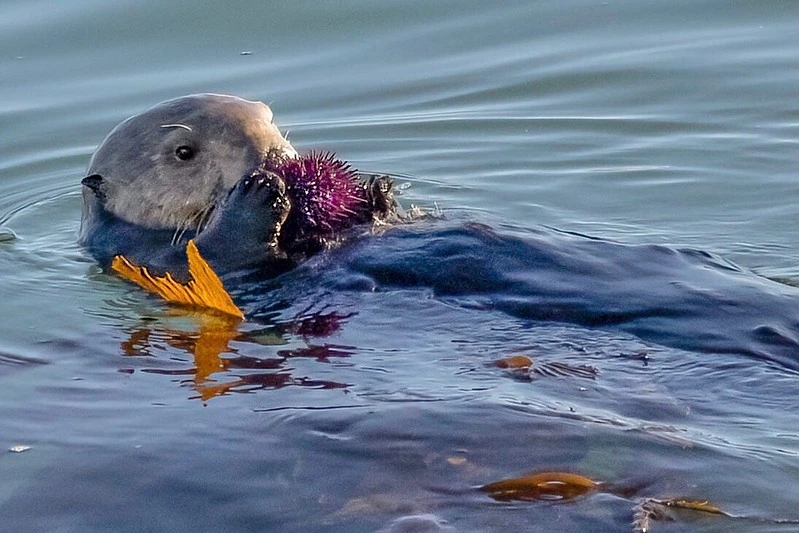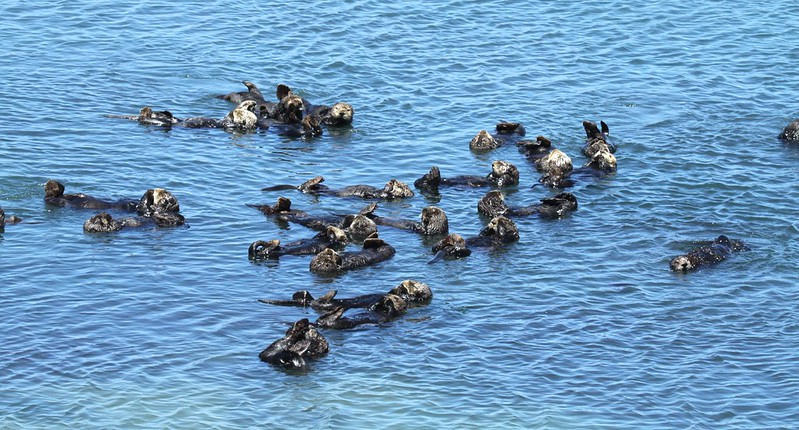The most seasoned ecosystem engineer at the Monterey Bay Aquarium sports a distinctly white fur head and white patches on her back. At 24 years old, Rosa is the oldest sea otter at the Aquarium. Since being rescued as an orphaned four-week-old pup in Santa Cruz in 1999, she has played a crucial role in supporting the sea otter population in California: over the years, she has acted as a surrogate mom for more than a dozen pups that were found malnourished and abandoned like she once was, showing them how to crack open abalone and how to groom themselves. Unlike other sea mammals, baby otters are entirely helpless without a mom, and they have to learn everything from scratch if they are to survive in the wild.
Historically, between 150,000 and 300,000 sea otters once occupied the coast along the North Pacific Rim from northern Japan in the northwestern Pacific to Baja California, Mexico, in the eastern Pacific. Otters don’t just hold the record for being the smallest marine mammal in North America, they also have the densest fur of any animal on earth, with up to a million hairs per square inch. (A human usually has less than 100,000 hairs on their entire head.) But what helps them survive in cold water was the cause of their near-extinction at the beginning of the last century.

At a behind-the-scenes tour at the Monterey Bay Aquarium, a volunteer passes around a thick brown-grey otter pelt. It is impossibly soft to the touch, making it immediately obvious why it was once such a coveted insulating material for coats and hats. “Unlike seals or sea lions, sea otters are not kept warm by their blubber but by their soft fur,” the tour guide explains. “This was the reason they were hunted to near extinction 100 years ago. Ninety-nine percent of sea otters were killed for their coat.”
Since otters became a protected species under the Endangered Species Act in 1977, northern sea otters have rebounded to about 100,000 otters in North America, mainly in Southeast Alaska and British Columbia, Canada. But the smaller southern sea otters still occupy only 13 percent of their historic range, with a population of an estimated 3,000 currently living on California’s central coast, according to the US Geological Survey. Their numbers once dropped as low as about 50 otters, and the experts at the Monterey Bay Aquarium have played a key role in rescuing pups.
Weighed down by negative news?
Our smart, bright, weekly newsletter is the uplift you’ve been looking for.Both the US Fish and Wildlife Service and Elakha Alliance, an Oregon nonprofit named after the Chinook term for otter, recently finished feasibility studies showing that it is not only possible to restore otters in their historic habitat but that it would yield enormous benefits as well as unique challenges. “Sea otters are a really critical part of our coastal environment,” Jane Bacchieri, the executive director of the Elakha Alliance, says. “Bringing back sea otters means making the coast more resilient.”
Without a healthy otter population to keep them in check, the number of sea urchins — the otters’ favorite food — ballooned, in some coastal parts of California, by 10,000 percent. The purple urchins, sometimes labeled “sea zombies,” have mowed down entire kelp forests in Northern California, with up to 95 percent disappearing since 2012. If the ravenous otters were returned to their historic habitat, they almost certainly would reduce sea urchin numbers and thus allow kelp forests and seagrasses to flourish again.
“Sea otters are the guardians of the kelp forests,” says Bob Bailey, the president of Elakha Alliance. The kelp, in turn, is not only crucial to the health of the marine ecosystem and provides a vital habitat for fish but also naturally sequesters carbon. As Matt Simon recently reported in WIRED, “If a kelp forest grows well, and half the carbon it absorbs is sequestered in the deep sea, it’d be the equivalent of canceling the emissions from 5 million automobiles.” Thus, an army of sea otters would immediately help fight climate change and likely improve water quality.
Otters are a keystone species. “They have an outsize effect on the ecosystem because they have an unusually high metabolic rate,” University of California, Santa Cruz, professor Tim Tinker, the lead author of the Oregon feasibility study, explains. “On a per capita basis, they simply consume orders of a magnitude unmatched by any other predator of comparable size. If you plotted their per capita effects next to sea stars, lobsters and other species that eat sea urchins, you’d have a bunch of tiny bars for all those others and an Empire State-Building bar for the effect of sea otters.”
Historically, in the North Pacific area where sea otters lived, urchins were never superabundant. “Consequentially, kelp forests have fewer defenses against them, and abalone are larger, giving them protection from otters,” according to Tinker. “They’ve been having these really strong effects for millions of years.”

Tinker originally studied seals but after signing up for a seasonal sea otter project, his fascination grew into a lifelong passion. “When you observe seals, you don’t see a lot of their foraging, simply because you can’t dive down to 1,000 feet,” he says. “But with sea otters, you can observe everything because they bring everything they eat to the surface. That immediately grabbed me.” He is considered the country’s — if not the world’s — foremost sea otter expert and has studied them for three decades. Yet he admits to learning new facts about them “every month.”
The otters are a fascinating example of how little we know about the interconnectedness of species. “We’re constantly learning new things,” Tinker says. For instance, he was surprised to see not only eagles but wolves and grizzly bears in Alaska taking sea otters out of coastal waters for dinner.
One aspect that makes sea otter reintroduction more challenging than other species is that they are extremely attached to their home turf. “We see some juvenile males venture up and down the coast, which is important for genetic diversity, but most if not all adult females, once they reach their reproductive age, stay in a stretch of coastline of between five and 15 miles at most,” Tinker shares. “Most females never leave their small home range for the rest of their lives.” This habit is also what made them so susceptible to the fur trade: “Hunters were able to serially hunt them out by moving down the coast, hunt them down completely in one area, then move on to the next.”
This ingrained trait is also the reason otters are so slow at naturally repopulating the areas they once called home. Fish and Wildlife officials reintroduced small groups of otters from Alaska to the Oregon coast between 1969 and 1971 and then in California in the late 1980s. In both cases, no otters stayed, probably because most tried to swim back home and died. An effort on San Nicolas Island, off the coast of Southern California, almost failed after the original 125 otters dwindled down to 12, but those last animals persisted and today there are about 150 otters at San Nicolas.
The otter reintroduction was much more successful in Southeast Alaska, where there are at least 23,000 sea otters — up from 450 otters that were introduced in the 1960s — and in British Columbia with at least 8,000 sea otters. Tinker emphasizes, “We know a lot more now. We won’t just release a group of otters and watch them die. That would be unthinkable today.” He is currently working on a model that lays out where repopulating sea otters would be most beneficial for the ecosystem and where they also would find the most conducive conditions along the California coast — for instance, estuaries where their number one predator besides man, white sharks, are unlikely to hunt. Shark bites are currently the most common cause of otter deaths in California.
With the protections for sharks yielding results, the increase in juvenile whites also means an exponential increase in interactions between sharks and sea otters. “The sharks appear to only take a test bite, probably mistaking them for juvenile seals,” Tinker speculates. “But for the otter that bite is almost always fatal.” In the future, some of these predators might help keep otter populations in check.
Where sea otter repopulation was successful, in Alaska, the fuzzy, voracious bipeds have become so numerous in some areas that crab and shellfish fishers view them as unwanted competition. An industry-funded report attributes a loss of $28 million dollars to the skilled furry shellfish hunters between 2005 and 2011.

Tinker has a comeback for that: At least in the Pacific Northwest, sea otters and humans have coexisted for 10,000 to 15,000 years. As the glaciers receded, humans and otters arrived at the same time. “Indigenous knowledge and archaeological evidence suggest that humans excluded sea otters from certain shellfish harvesting areas, enabling coexistence. We think there are lessons there that might help us ‘re-learn’ how to coexist today,” Tinker suggests.
The Elakha Alliance, which was founded by the late David Hatch, a member of the Confederated Tribes of Siletz Indians, is working with US Fish and Wildlife, tribes, shark specialists, environmental groups and fishery advocates along the coast to develop a reintroduction plan that considers all involved parties.
In Southeast Alaska, Tinker is part of a working group that includes federal and state biologists, crab fishermen, native experts, scientists and environmentalists. The working group meets monthly “to go over the latest science and talk about outreach issues,” Tinker shares. “It has been really successful. Because everyone is engaged, there’s no shouting. We have a productive dialogue where we can explore different solutions and it’s not just a bunch of people yelling at each other.”
One issue they’re discussing is hunting rights. “Alaskan natives have the right to hunt sea otters and use their pelts,” Bailey explains. There are no similar rights for indigenous people in Oregon and California, but both Bailey and Tinker consider the possibility of including such rights.
In the same spirit, Tinker just participated in a town hall meeting in California’s Sonoma County, one of the potential repopulation sites. “Getting the dialogue going between all people who have an interest,” Tinker says. “It takes decades to build trust so people are engaged and feel ownership in what’s happening. That there are different viewpoints is a good thing.”
Maybe in a few years, more estuaries along the California and Oregon coast will look like Elkhorn Slough, a 7-mile-long tidal slough and estuary in Monterey Bay, California, where otters have fully recovered. Dozens of sea otters float on their backs across the still surface, some holding their babies on their bellies and grooming their fur. “We’ve seen a massive increase in seagrass abundance here that we attribute directly to the otter recovery,” Tinker says. He has also observed reduced erosion and a significant effect on invasive green crabs. “Otter reintroduction has all these cascading effects we are learning in real time. We hadn’t anticipated this before.”
Elkhorn Slough is where the Monterey Aquarium currently releases many of its rescued and rehabilitated sea otter orphans. Some, like Rosa, are deemed unreleasable. If an otter is not doing well on its own, scientists will recapture it, as they did with Rosa, and nurture it back to health.
“I have a feeling if we’re having another conversation ten years from now, there will probably be another five or six things that I have no idea about right now because otters haven’t been here long enough,” Tinker says.






